Editor’s Note: Today’s post is a guest submission from HHR’s good friend Anonymous in Houston
Vintage Ads posts here at HHR are a way to visually look at retail history during a brief period of time. In my last Vintage Ads post last summer, I discussed the introduction of audio Compact Discs and CD players to Houston’s retail scene in 1983. Today’s Vintage Ads post will also be about electronics retailing, but the focus of today’s post will be about two big box computer store chains, both of whom were based out of the Dallas-Ft. Worth Metroplex, who came to Houston early in their national expansions, CompUSA and Computer City.
Computer retailing was a bit of a wild west scene in the 1980s. Computer specialty stores existed in the 1980s, but many of these retailers focused on the lucrative business market. Many of the business computer stores at the time were small, independent businesses. Home users found these stores to be intimidating as the sales staff often had little patience for those without computer knowledge. On top of that, many home and business users were uneasy about spending thousands of dollars on equipment from ‘here today, gone tomorrow’ type small businesses. Sears, for example, tried to take advantage of their sterling reputation in the 1980s by starting standalone computer stores called Sears Business Systems Centers, but these stores were not aimed at the home users.
Discount and department stores sold home computers such as the popular Commodore 64, but these stores often lacked employees who could assist home users in picking the right hardware and software. This was a major problem given that most people were computer illiterate in the 1980s and computer hardware and software was extremely expensive and proprietary at the time. With all these problems, many home users bought computers in the 1980s which ended up collecting dust and which became outdated very quickly. However, with computers gaining popularity in the workplace and with technology advancing and becoming easier to use, it was inevitable that home users would look to buy computers again as the 1990s approached. After all, who didn’t want to buy their groceries online from Gerland’s Food Fair in 1989?
One retailer who tried to combine a stable, familiar name with consumer-oriented sales approaches was Fort Worth’s Tandy Corporation. Tandy’s computers were extremely popular in the 1980s due to them being available at Tandy’s own Radio Shack stores all across the country. Just about every major mall in the US had a Radio Shack store, as seen in this 1987 video touring two Radio Shack stores, which could demonstrate computers to new users. Tandy even opened specialized computer stores in the 1980s called Radio Shack Computer Centers which had expanded computer offerings and user training for both consumers and businesses. Furthermore, Tandy attempted to compete with the growing category-killer electronic big box stores, such as Circuit City and Best Buy, by purchasing the McDuff chain of stores. Under Tandy’s leadership, McDuff sold both Tandy and non-Tandy computers.
Loyal HHR readers might remember last October’s post about how OfficeMax’s stores in Houston started out under the BizMart chain. As mentioned in that post, BizMart, another retailer from the DFW Metroplex, was co-founded by a former Tandy executive and they also focused heavily on selling computers. A different group of businessmen in the Metroplex thought they had a winning formula for selling computers and this led to Soft Warehouse. Soft Warehouse came to Houston in 1989 at 12230 Westheimer Rd., Houston, TX 77077. This building was recently featured at HHR due it becoming a new 99 Ranch Market location here in current times.
Soft Warehouse brought a revolutionary concept to Houston when they opened in 1989. Their style of retailing was similar to the early office supply big box warehouse stores in terms of stacking items out on the salesfloor and selling it cheaply, but Soft Warehouse also offered in-store service and sales staff to help both home users and business users. Thus, Soft Warehouse attempted to appeal to both computer novices and the most experienced HAL-PC members. As a computer user in the 1980s, I remember visiting Soft Warehouse early on and while the store was not memorable from a décor or fixtures perspective, it was amazing how much stuff they had for computers under one roof and how the stores were free from high-pressure sales staff like other computer stores.
Although I loved the Soft Warehouse name, it seemed that Soft Warehouse’s executives ran into problems with the name and decided to rename the chain to CompUSA in 1991. Reasons given at the time revolved around CompUSA’s ambitious national growth plans and wanting to reinforce that their stores were not just software stores, but complete computer stores. After all, stores which focused on software, such as Egghead Discount Software (for images of the Houston North Oaks Mall Egghead, check this website out), Media Play, Babbages, and Software, etc., were common in those days.
At around the same time in 1991 that Soft Warehouse was changing their name, Houstonians also got word from DFW that Tandy was going to open two new computer superstores in Houston called Computer City. One location was at Bissonnet & Weslayan and the other at The Commons across I-45 from Greenspoint Mall. These were both former Highland Superstore locations. I was personally excited about the Greenspoint location because that was much easier to get to than the CompUSA location on Westheimer. It should be noted that a handful of various unaffiliated independent computer stores used the Computer City name throughout the Houston area in the late 1970s through the early 1990s, but these businesses were not connected to Tandy’s efforts. One of those independent Computer City businesses in Houston was even big enough to advertise on local TV.
At the time, Tandy believed they needed retail concepts aside from their strong Radio Shack stores to stay viable as they entered the 21st century, but Tandy seemed a bit uncertain on which retail concepts would work. They already had McDuff which sold computers, electronics, and appliances and they already owned VideoConcepts, a chain of electronics stores purchased from Eckerd Corporation which were often located in malls like some McDuff locations. Now, they were trying to make Computer City a national chain and they also had this wacky idea called Incredible Universe which seemed like some kind of combination McDuff, Computer City, and Disney World. Computer City initially started out as a Southern California computer superstore owned by Inacomp Computer Centers and Mitsubishi before Tandy bought the concept in 1991.
It was inevitable that some of Tandy’s experiments would fade away as Tandy was competing against themselves in many ways. Sure enough, the Radio Shack Computer Centers, McDuff stores, and VideoConcepts stores faded away and by the mid-1990s, Tandy focused on Radio Shack, Computer City, and Incredible Universe. This was great for me as the McDuff closest to me at FM 1960 W & Jones Rd. closed and briefly became a Radio Shack clearance store before re-opening as a Computer City Express, a downsized Computer City store. While I still preferred shopping at the Greenspoint Computer City store since it was a full superstore, the Express store was so close by that it was a very handy stop. Eventually, the larger McDuff at The Commons across from Willowbrook Mall was converted into a full Computer City Superstore and I finally had a computer superstore in my immediate area.
CompUSA started opening more locations nationally and locally as well. Their second Houston location opened in Cypress Station in 1993 in between two then-new retail concepts in Houston, Venture and the Cypress Station Kroger Signature store discussed at HHR last February. This was such an exciting event that we visited the Cypress Station CompUSA several times during the store’s soft grand opening and then we waited in line during the store’s formal grand opening. For a complete listing of Houston CompUSA locations, refer to Mike’s CompUSA page.
Like with Office Depot and OfficeMax, CompUSA and Computer City were more similar than they were dissimilar. In terms of store décor and atmosphere, I think Computer City had a slight advantage. They were more like OfficeMax in terms of having a slightly more open store layout with more vivid décor. CompUSA was more like Office Depot in terms of austere décor which focused more on stacking items high and emphasizing the variety of brands they sold. Indeed, CompUSA did have one advantage early on in that they sold Dell Computers at a time when Dell was thought of as a mail-order only company. Unfortunately, CompUSA only sold Dell computers for a brief number of years. Vampire Robot’s YouTube channel has video footage from inside CompUSA stores including this clip from 1997 and this clip from 1999. The Portal to Texas History also has footage from inside CompUSA stores such as this KXAS-TV news clip from 1993 and this KXAS-TV B-roll clip from 2000. Finally, here is a complete CompUSA sales circular from 1999.
Perhaps not surprisingly for a Tandy operation, Computer City was fairly aggressive in wanting customer’s shopping data. Although I can’t remember if Computer City asked for a phone number and address anytime someone bought something from them like Radio Shack did, they did have a customer loyalty card. One Radio Shack Battery of the Month Club-like perk of having a customer loyalty card was that anytime you went to the store, you could get a free floppy diskette if you showed your loyalty card. In the early-to-mid 1990s, this was quite a perk as diskettes cost about $1 each. Of course, re-formatting useless America Online diskettes which came in the mail was another option in those days for those wanting free floppy diskettes!
Although it seemed to me that Computer City and CompUSA were fairly equal in their offerings and pricing, CompUSA seemed to gain more traction nationally than Computer City. It probably didn’t help that CompUSA’s administration was focused on one store format whereas Tandy was experimenting with various different formats while still trying to grow their established Radio Shack chain. As Incredible Universe failed, and as Computer City seemed to be losing to CompUSA, it seemed that Tandy wanted to focus on their one winning format, the traditional Radio Shack stores. Thus, in 1998, Tandy sold their Computer City operations to CompUSA and some Computer City stores closed and others were converted to CompUSA stores including the Willowbrook The Commons location.
Unfortunately for CompUSA, they had their own struggles even though they no longer needed to worry about competition from Computer City. Wealthy Mexican businessman Carlos Slim, who owned stakes in many US big box retailers, bought a controlling stake in CompUSA in 2000. As people became more accustomed to using computers in the 2000s, computer customers started to become more price-oriented than service-oriented. Competitors online and other B&M competitors like Wal-Mart/Sam’s Club and Best Buy often had better pricing than CompUSA. In the few places that had them, both MicroCenter and Fry’s Electronics had lower prices and more selection than CompUSA. MicroCenter also had better service and better looking stores. In Houston, not only did we get CompUSA and Computer City early on, but we also got both Fry’s Electronics and MicroCenter. Once those stores opened, with MicroCenter opening in Houston in 1994, they were the destinations for computer shopping for many Houstonians, not CompUSA.
The late 2000s were a difficult time for big box retailers and CompUSA was one of several big box chains that went out of business at that time. There were two large waves of CompUSA store closings in 2007 and the original CompUSA went out of business following that second wave of closures. Online computer retailer Systemax/TigerDirect bought CompUSA’s trademarks and relaunched the brand in 2008 as both an online and B&M retailer. Je of the Louisiana & Texas Retail Blog covered the Bunker Hill TigerDirect-era CompUSA store during the brief time it was open. By 2012, the TigerDirect-era CompUSA died just like Computer City and the original CompUSA.
Today, most Houstonians wanting a B&M computer superstore experience only have one option, MicroCenter. That said, I am sure that most MicroCenter shoppers strongly prefer MicroCenter over their memories of CompUSA and Computer City even if MicroCenter’s current Houston location is, to say the least, far from ideal from an access standpoint. Altex is another good alternative for those who, like myself, live in Northwest Houston.
Hopefully this Vintage Ads post illustrates the excitement around CompUSA and Computer City during their early days in Houston. While it is easy to dismiss these chains as being failed versions of MicroCenter, there was a time when CompUSA and Computer City filled major needs for Houston’s computer users. Furthermore, stores like CompUSA and Computer City were great places to get hands-on experience with the rapidly changing technology in the 1990s and understanding all the new things computers could do for business and home users. If you have any thoughts or memories of CompUSA or Computer City, please feel free to leave a comment in the comments section below. We love to hear from our readers!

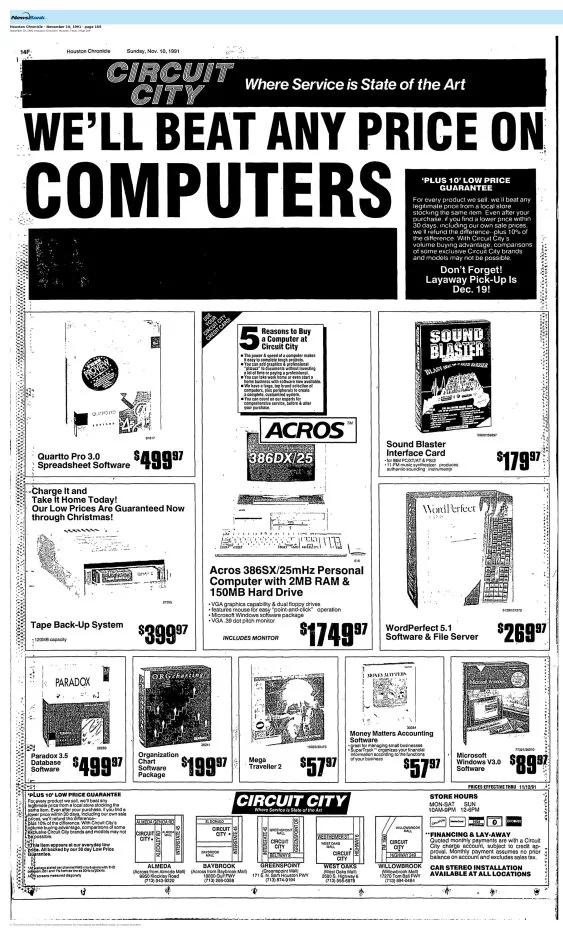
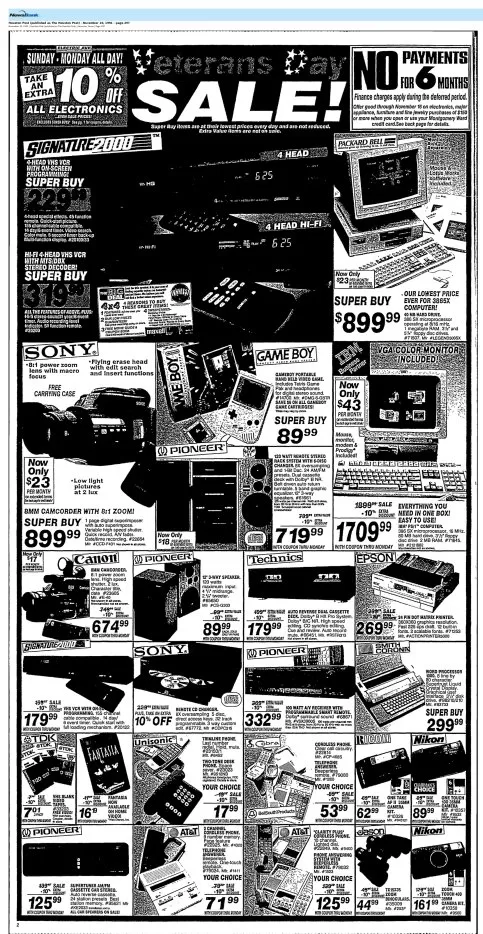
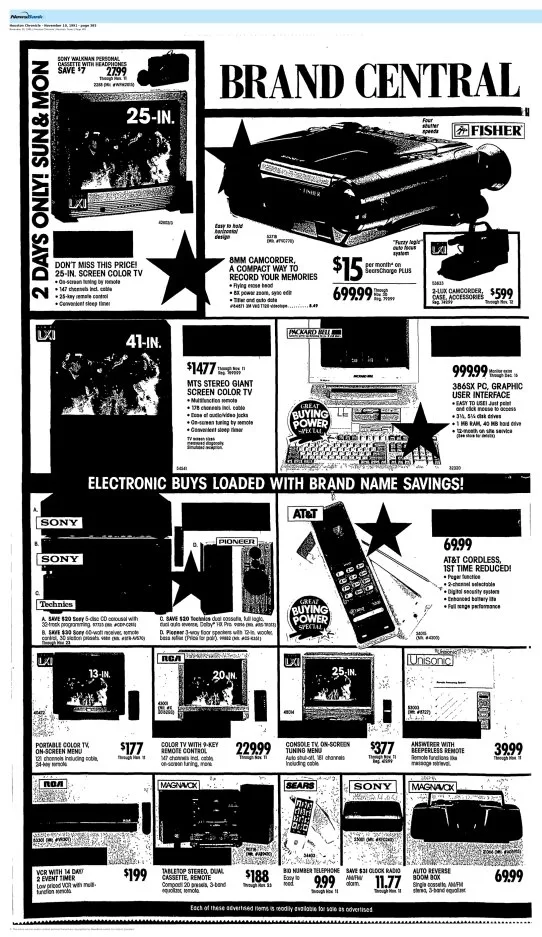

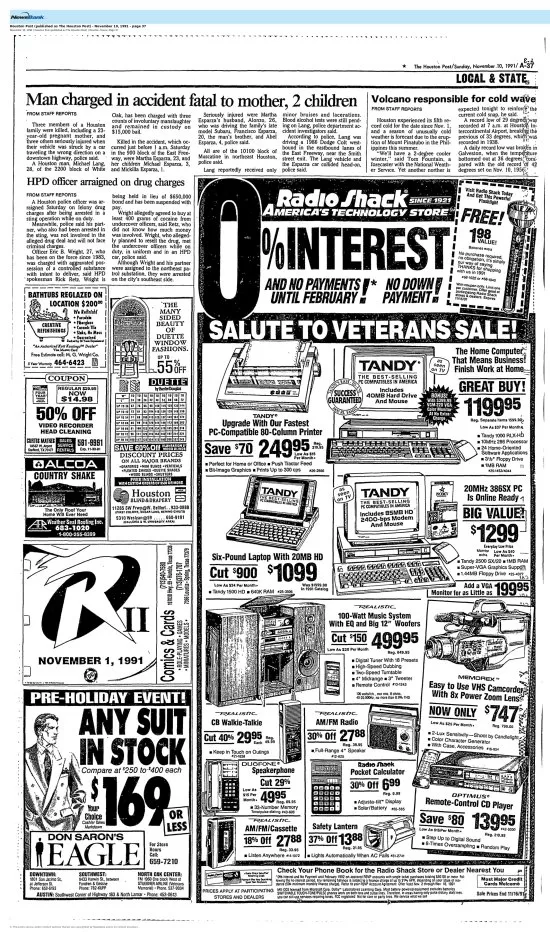
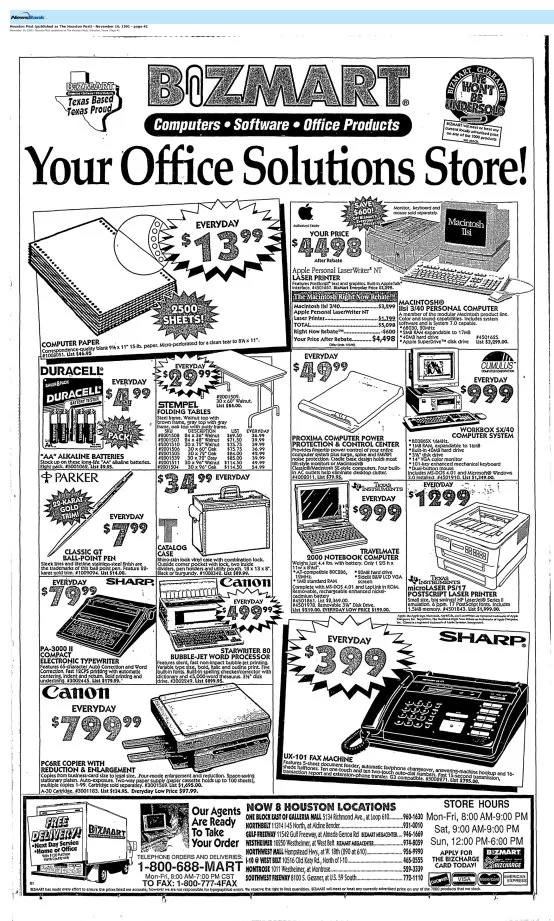

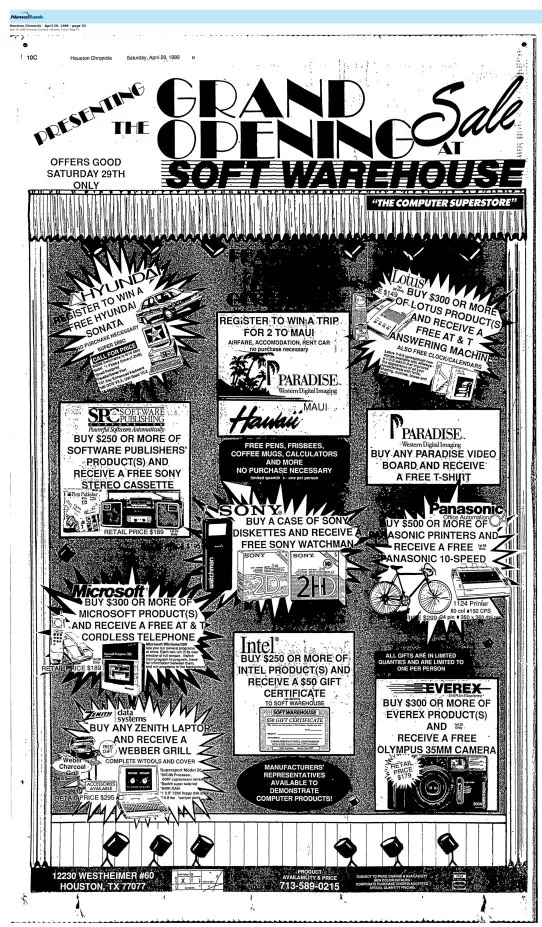
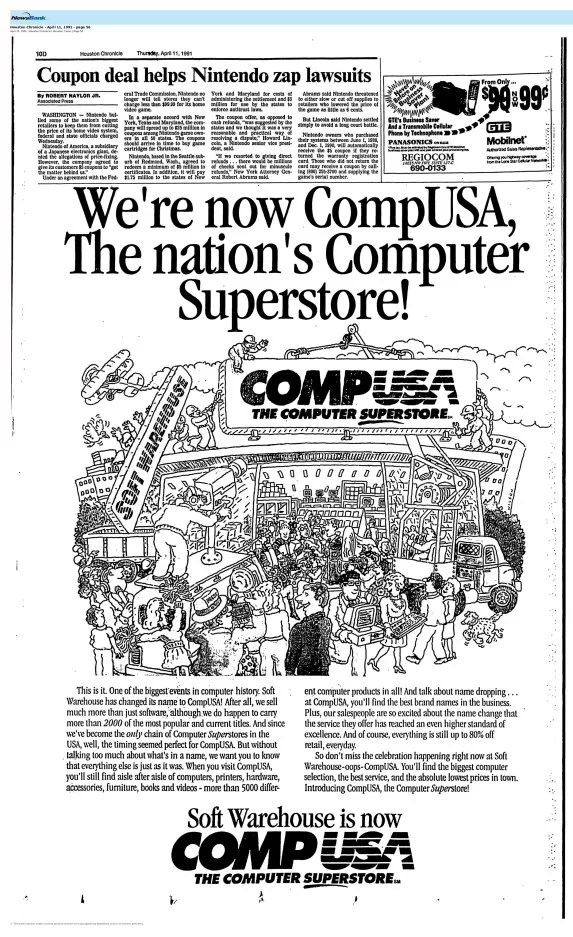
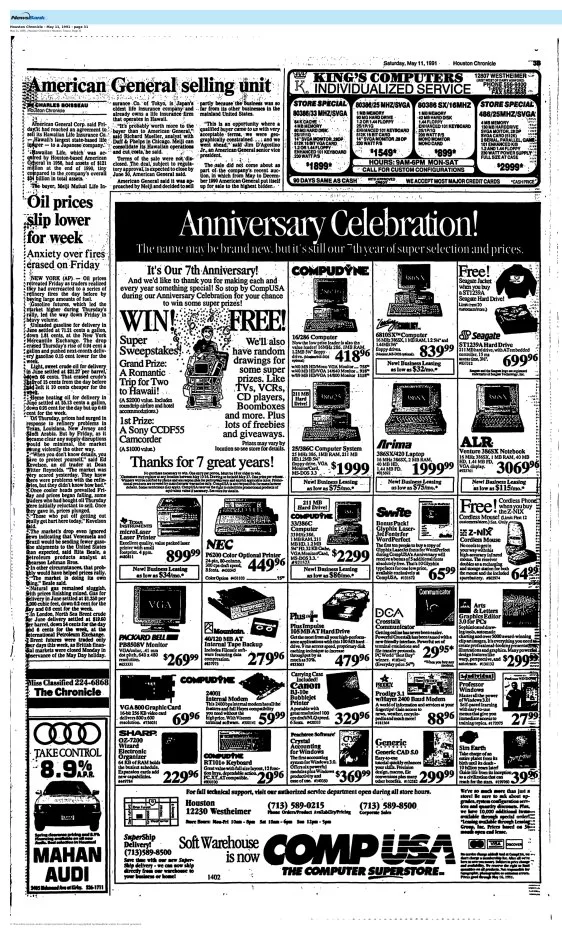
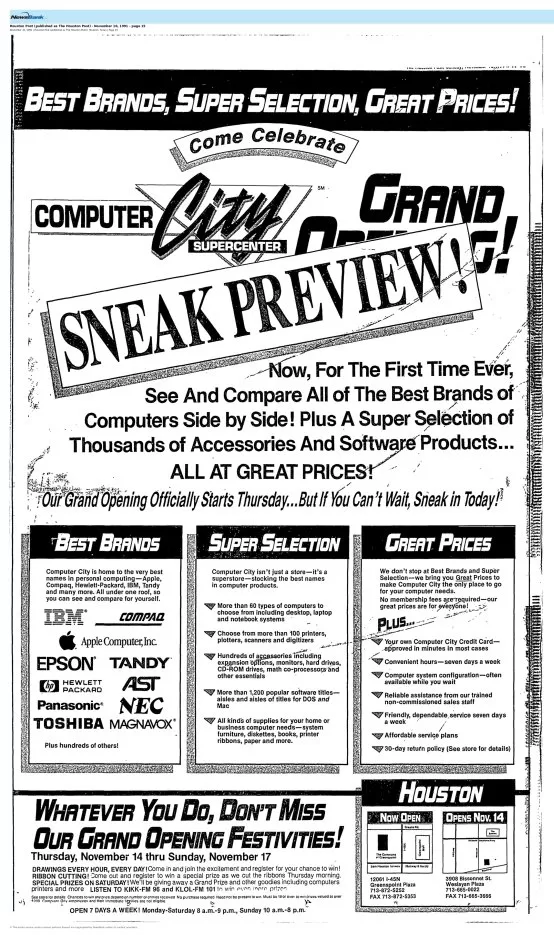
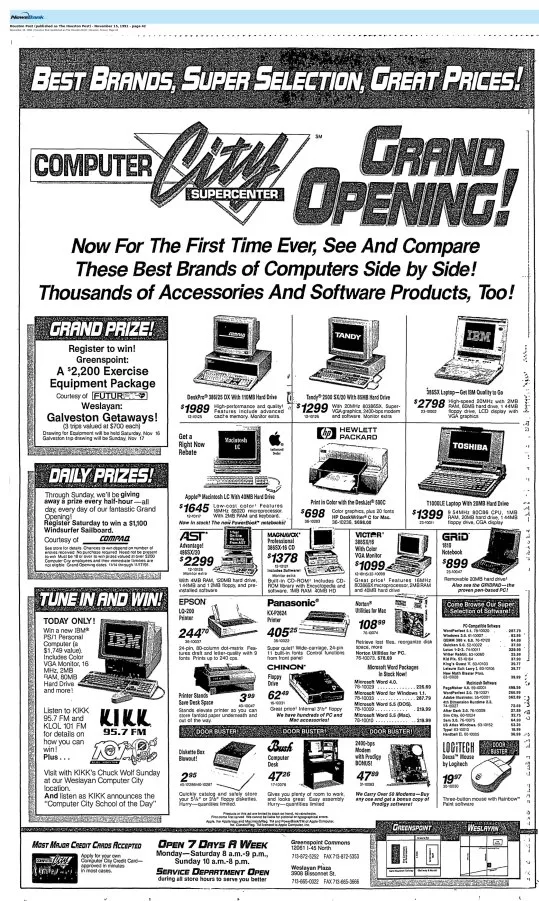
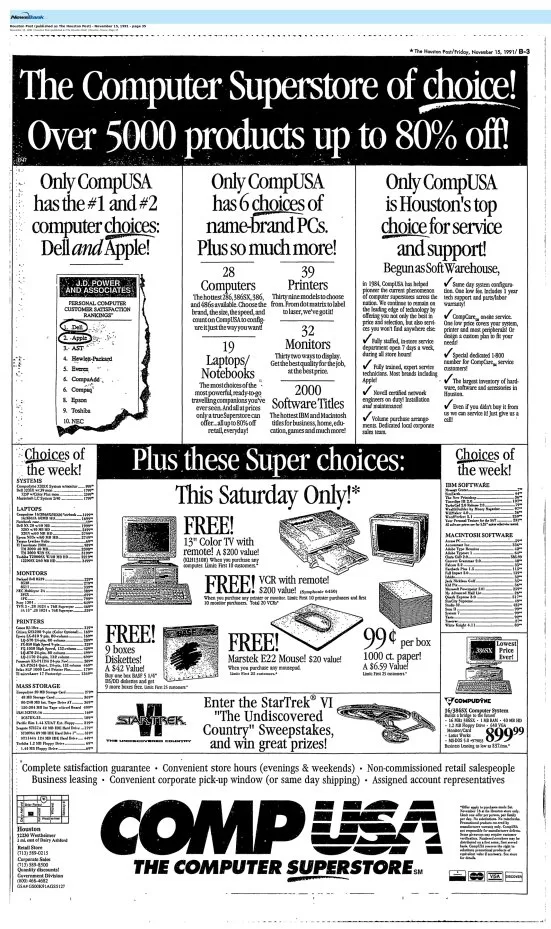

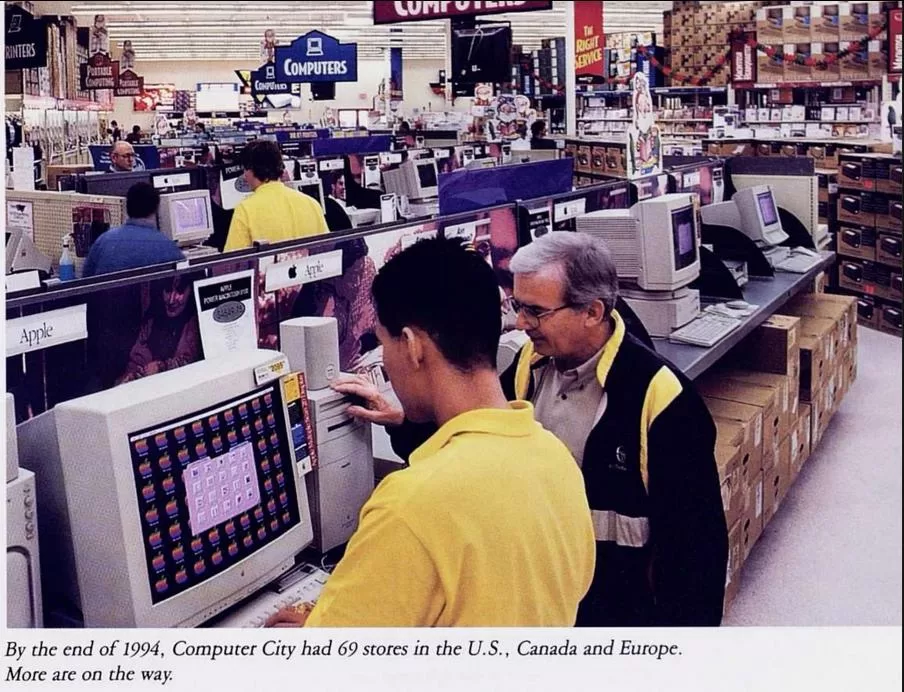


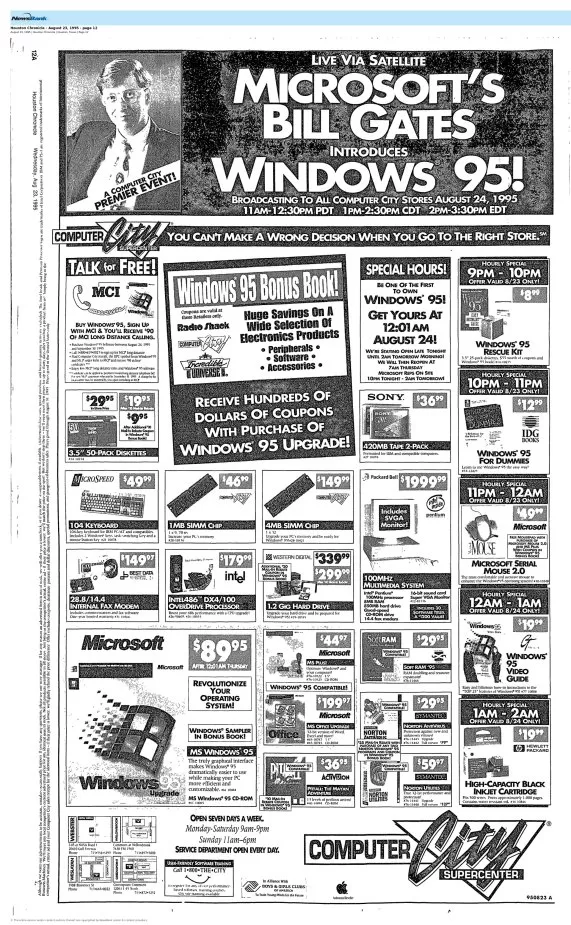
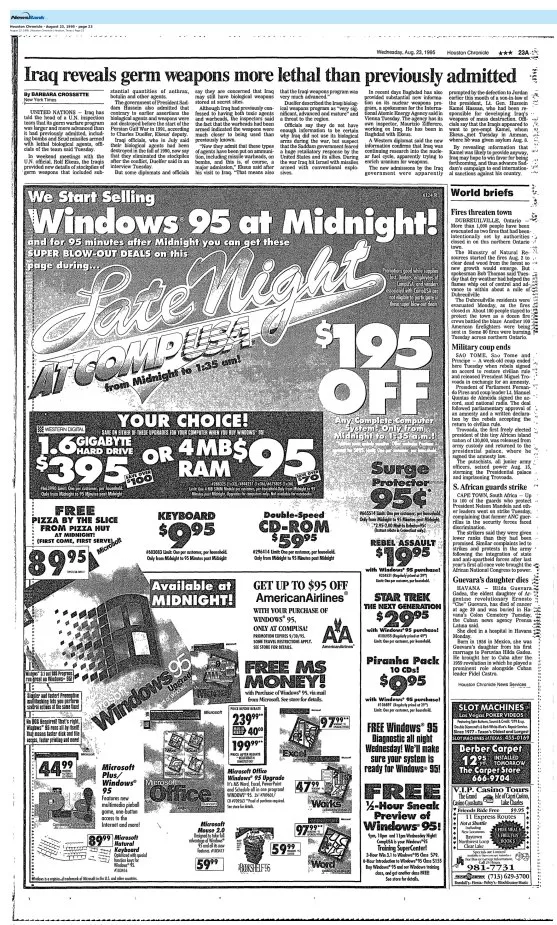
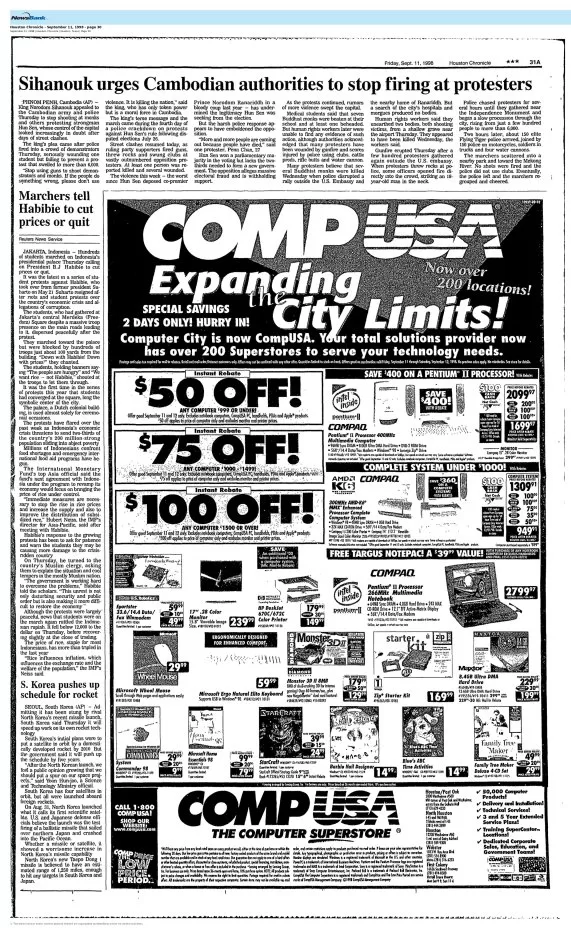
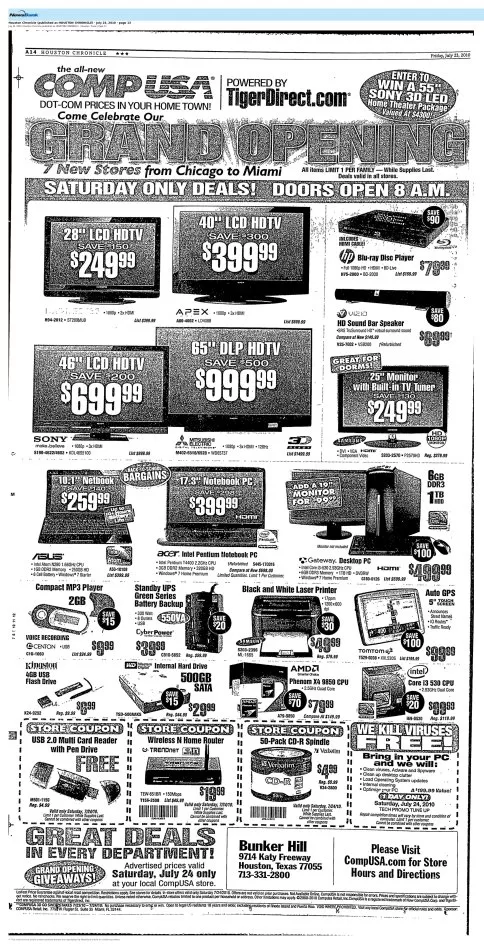
The discussion here about the early days of computers is misleading and I recommend reading history books instead. In the pre-DOS era, TRS-80 greatly outsold Apple, especially in the business market, where they were doing so well they started a separate computer store chain.
It’s just silly to comment that either one should be compatible with PC-DOS before PC-DOS came out! The only reason Apple II outsold TRS-80 in the end is because they continued to build them an extra 10 years, long after the machine itself was utterly obsolete. Apple did a great job cultivating the educational market.
After the IBM PC came out, very few companies, Compaq most prominently, were willing to take on IBM’s lawyers and build a compatible, but Radio Shack was EXTREMELY successful starting with the Tandy 1000 series in 1984. In the same time period they had a 100% compatible XT clone (with hard drive) at half IBM’s price.
Ultimately it was the combination of availability of chipsets and the rise of mass manufacturing in China that made commodity PCs cheaply available in discount stores, and as the commenter said, white-box builds were born as well. Radio Shack’s fate was sealed around 1989, because they should have either bought a more nimble supplier, or offered PC-building parts kits to begin a new chapter in their DIY legacy.
Oh look! It’s a Tandybear! I haven’t seen one of those in decades! Come over here and let me stroke your mangy, delusional fur, Tandybear…
Hah hah. Don’t take my word for it.
Pricing was certainly an issue for Tandy in the late 1980s and early 1990s and the ads in the post do show that. Taking a look at the November 1991 ads, Radio Shack was selling a Tandy 286 10 MHz/1 MB RAM/40 MB HDD computer with monitor for $1199. Meanwhile, Dillard’s was selling a Magnavox 386 SX 16 MHz/1 MB RAM/40 MB HDD computer with monitor and with Lotus 1-2-3 (a very popular spreadsheet program at the time) for $1299. Bizmart had a Cumulus 386 SX 16 MHz/1 MB RAM/40 MB HDD computer with monitor for $999 and that was the regular price! Given what the other offerings were in the same price range for lower-end IBM compatibles, the Tandy 286 was a poor value at the time.
Great article!
Tandy sealed their fate long before they opened or purchased these other chains with a fatal mistake involving Radio Shack.
In the late 70s and early 80s, Tandy’s TRS-80 line of PCs were perhaps the best known and most used brand by home geeks and many small businesses (and sold only at Radio Shack). Until IBM offered the first DOS (the Microsoft precursor to Windows) based PC in 1981, the only serious competition for DOS from a real PC (not a glorified toy like Texas Instruments’ TI-99 or Commodore) was an almost unheard of company selling a model called the II-E (Two-E): Apple.
The TRS-80 was completely incompatible with any software or accessories requiring Microsoft’s DOS (and later Windows) operating system. Business and educational users were setting up camp around either Microsoft or Apple; Tandy’s TRS-80 went from hero to has-been in just a few years.
The fatal mistake was for Radio Shack to give Microsoft the middle finger and pretend DOS didn’t exist. This opened the free-for-all PC selling at both big box and small specialty stores. By the time Radio Shack finally started carrying a few Windows-based PCs in the 90s, the nail was already in the coffin.
Yes, for as popular as the TRS-80 was, Tandy was not nearly as competitive trying to sell IBM compatibles in the late 1980s and early 1990s. I know Tandy tried to give their IBM compatibles some extra graphics and sound capabilities compared to similar computers from other makers, but this was not enough to give them any kind of major edge in the market. As we can see from the ads in this post, there was plenty of competition for Tandy by the early 1990s so it isn’t surprising that they got out of the computer manufacturing game by selling the computer division to AST much like how Tandy later dropped the Computer City division.
My thought is Tandy should have noticed Microsoft’s dominance very early on and gone full force on selling their own brand of DOS/Windows PCs by the mid 80s. That, or possibly buying out an established name like Gateway and making it a Radio Shack exclusive.
It did seem that Tandy was probably too focused on selling IBM compatibles to home users rather than business users in the early days. The Radio Shack Computer Centers did try to appeal to business users, but I’m not sure if their marketing was focused enough on businesses. It seemed that in the 1980s and into the early 1990s, the people buying IBM compatibles were either businesses or home users buying something like what they had at the office and I’m not sure if the Tandy name had the same value with those customers as the likes of IBM and Compaq which were very focused on business users.
I do remember noticing in the early 1990s that Tandy’s 486 computers were almost always 486 SX systems aimed at value-oriented home users (probably to compete against the Packard Bells sold at Sears, Montgomery Ward, and elsewhere) rather than the 486 DX systems which business and power home users wanted. With that, I can see why more discriminating computer buyers looked elsewhere to buy their computers.
As for me personally in the late 1980s/early 1990s, I preferred assembling my own computers or buying them from local system integrators. Most of the computers sold at big stores at the time used a lot of proprietary/integrated components which made upgrades and general hardware configuring more of a challenge.
“reformatting useless America Online diskettes”
XD
As a young single guy struggling to make ends meet every month in the early 90s, it was a highlight of my day when I opened the mailbox and found one of those America Online baggies inside. Yay! Free disk! I’d immediately strip out the disk and toss the rest of it into the trash can in the apartment complex mail room. Their sales pitch never even made it into my apartment. Thanks for supplementing my income during the lean years, AOL!
Great article, by the way. Thanks for the stroll down memory lane. I miss the experience of browsing through those big computer stores in the 90s — even if I couldn’t afford to buy anything from them at the time.
Thanks, I’m glad you liked the post! Computer hardware and software was so expensive in the 1990s, especially the early 1990s, that I did a lot of ‘window shopping’ at these computer stores and I also looked for freebies when I could like with those AOL disks and also with the free Computer City disks. It was exciting to see the new technology and know that someday it would become more affordable. One random memory was that I first used an Intel Pentium computer at Computer City not long after the Pentium was released. It was an AT&T Globalyst computer system. Yep, AT&T used to make desktop computers! But, anyway, it was neat to sample the new technology like that at places like Computer City and CompUSA.